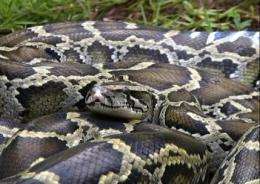Burmese pythons slithering their way north?

(AP) -- One by one, seven slithering Burmese pythons were dumped into a snake pit surrounded by 400 feet of reinforced fence at the Savannah River Ecology Lab in South Carolina.
As they were released last week by a handful of scientists, some of the serpents hissed and lunged, baring their fangs. Others coiled up under the brush. Two slid into a pond in the center of the pit, disappearing in a snaking trail of bubbles. Some were more than 10 feet long and thicker than a forearm. And for the next year all of them will call this snake pit - an enclosed area of tangled brush and trees - home.
Ecologists will track the exotic pythons, all captured in Florida, to determine if they can survive in climates a few hundred miles to the north. Using implanted radio transmitters and data recorders, the scientists will monitor the pythons' body temperature and physical condition.
The test could show whether the giant imported snakes, which can grow up to lengths of 25 feet, are able to spread throughout the Southeast.
The fast-growing population of snakes has been invading southern Florida's ecosystem since 1992, when scientists speculate a bevy of Burmese pythons was released into the wild after Hurricane Andrew shattered many pet shop terrariums.
Now scientists fear this invasive species is silently slithering northward.
"They of course have an impact on native species," said herpetologist Whit Gibbons, a professor of ecology at the University of Georgia and a member of the python project. "If you have a big old python eating five times as much as another species that eats the same prey, it's a competitive thing." The pythons compete with alligators, among other top predators.
Gibbons said a human is "just another prey item" to a python - especially a small human. Pythons are constrictor snakes and have been known to eat people in their native areas of Southeast Asia, he added.
"A 20-foot python, if it grabbed one of us, would bite us and then within just - instantly - seconds, it would be wrapped all the way around you and squeezing the life out of you," Gibbons said.
While pythons don't make a habit of attacking people and most aren't large enough to eat a person, Gibbons called the possibility a "nightmare."
"What about the first kitty cat they eat? Or the first little poodle? They'd love poodles, I imagine," he said.
Mike Dorcas, a professor at Davidson College in North Carolina, has sliced open pythons in Florida to find the remains of white-tailed deer, bobcats and large birds.
Dorcas is leading the experiment at the Savannah River Ecology Lab as part of a collaboration between the U.S. Geological Service, the National Park Service and the University of Florida.
He was prompted by a study released last year showing that the native habitat of Burmese pythons in Asia is a climate match for much of the southeastern U.S.
"The question is really, well, can they survive in a place like South Carolina or North Carolina or Arkansas or Tennessee?" Dorcas said.
One day before releasing the pythons into the pit, Dorcas snapped on latex gloves and surgically implanted radio transmitters into all seven. The transmitters enable scientists to keep track of the pythons' location and allow them to hunt down any that manage to escape.
What are the chances of escape? "We never want to say never. We've made the enclosure as snake-proof as possible but we've taken some other precautions," Dorcas said, noting that all of the pythons are males, so they wouldn't be able to reproduce.
The ecologists also inserted micro data loggers into each snake to record the internal temperature of the python every hour. After a year, Dorcas will remove the chips and download the information into a computer to discover how the snakes thermoregulate in a cooler climate.
Pythons are masters of disguise - slippery and quick - and all but one of the serpents was invisible within minutes of being deposited into the pit.
So counting pythons in the wild is a daunting task. Scientists don't have an accurate estimate of how many pythons are in Florida.
"It's certainly in the thousands, or tens of thousands, if not hundreds of thousands," said Gibbons.
©2009 The Associated Press. All rights reserved. This material may not be published, broadcast, rewritten or redistributed.


















